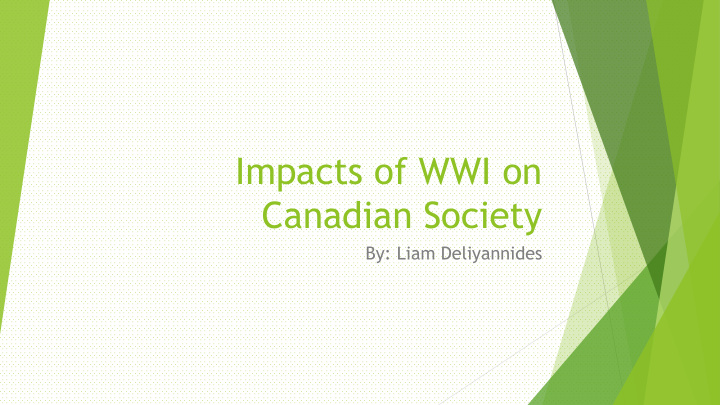



Impacts of WWI on Canadian Society By: Liam Deliyannides
Debt/ Taxation: - Canada’s efforts in war lead to massive debt problems - This lead to a massive inflation of taxation - The lower class were outraged Propaganda Posters - Led to Propaganda posters in order to receive donations - These propaganda went much better than expected
Debt/ Taxation: Exports: - Mass exports of Timber/ Wheat assisted in Canada’s debt problems - Canada had 2 export countries, Britain and USA - Canada attempted to import very little good, in order to lower debt Results: - These three ways of overcoming debt assisted, but didn’t overcome Canadas debt problems - This past debt, likely contributes to Canada’s currents debt
English and French Canadian Relations: - Rumors suggested the French- Canadians would turn on the English - This Resulted in hatred between French and English Canadians - Led to many political parties, either supporting the French, or English - When WWI ended, the English government showed their respect for French- Canadians - The government enrolled French as a course within schools across the country
Autonomy: - WWI Reflected Britain’s reliance on their Commonwealth Colonies - Canada consistently assisted Britain throughout the war - The Canadian Military proved itself in battles such as Ypres, Passchendaele, and Vimy Ridge - Britain showed their appreciation for Canada, allowing them to sign the treaty of Versailles
Women’s Rights: Occupations: - Due to men being sent to war, there was many job openings for women - These included factory jobs, mainly involving military supplies - When the men returned the women kept these jobs, leading to a larger variety of jobs open for women - Before this, teachers, nurses, or maids were the only acceptable occupations for the women
Women’s Rights: Voting Rights: - The push in women’s occupations caused women to push for voting rights - Suffragists claimed they would make a positive political difference - Suffrages achieved voting rights for women in Manitoba in 1916 - Voting rights for women spread throughout Canada in 1919 - Women continued to push for more rights, prior to WWI
Racism/ Discrimination: Multi- Cultural Military Enrollment: - Originally Foreign Canadians weren’t allowed to fight for Canada - French, and English- Canadians were the first allocated to serve - As less people began to volunteer, more Foreigners were allowed to volunteer - Over 4 000 Aboriginals, and around 300 Asian Americans fought for Canada in WWI - These soldiers would fight alongside White Canadian Soldiers
Racism/ Discrimination: Racism Throughout WWI: - Germans, and Austria- Hungarians were not allowed to fight due to their enemy heritage - Foreign Canadians who served were not given the same gratification as English and French Canadians - This led to many protesting the treatment of Foreigners - Riots began to outbreak throughout Canada
Racism/ Discrimination: War Measurement Act: - The Government implemented a War Measurement Act during WWI - This Act was heavily favored against the Germans and Austria- Hungarians - They were forced to carry an ID Card at all times - They could be arrested without a fair trial - They were often held in internment camps - This was to limit enemy spies throughout Canada, and to make sure they weren’t living among dangerous citizens
Pandemics: - Many Soldiers returned from the war with a severe flu - This spread throughout Canada Rapidly - This flu was known as the “Spanish Flu” or “La Grippe”. - This led to 50 000 deaths of Canadians, and 21 Million deaths worldwide - Killed more people than the Black Death - Masks were mandatory in public - Schools temporarily closed down throughout the country
Conscription: - Conscription is the Random selections of citizens to fight in the war - Due to limited citizens volunteering for WWI near the end of the war - Military Service Act placed Conscription upon Canada - All Canadian Citizens between ages 20- 45 were forced to fight if selected by the Government - Controversial throughout Canada - French- Canadians were outraged, as this forced some of them to fight for the British
Bibliography: Canada, Veterans Affairs. “First World War (1914 – 1918).” Veterans Affairs Canada , 30 Oct. 2017, www.veterans.gc.ca/eng/remembrance/history/first-world-war. Drews, Keven. “WWI Racism: Black, Asian and Aboriginal Volunteers Faced Discrimination.” Thestar.com , 9 Aug. 2014, www.thestar.com/news/canada/2014/08/09/wwi_racism_black_asian_and_aboriginal_volunteers_faced_discrimination.ht ml. Government of Canada; Indigenous and Northern Affairs Canada. “Aboriginal Contributions during the First World War.” Government of Canada; Indigenous and Northern Affairs Canada , 24 Oct. 2014, www.aadnc- aandc.gc.ca/eng/1414152378639/1414152548341. “Legacy - The War's Impact on Canada.” Canada and the First World War , www.warmuseum.ca/firstworldwar/history/after- the-war/legacy/the-wars-impact-on-canada/. Morton, Desmond. “First World War (WWI).” The Canadian Encyclopedia , www.thecanadianencyclopedia.ca/en/article/first- world-war-wwi/. “Recruitment and Conscription - Conscription, 1917.” Canada and the First World War , www.warmuseum.ca/firstworldwar/history/life-at-home-during-the-war/recruitment-and-conscription/conscription-1917/. “The War Economy - Finance and War Production.” Canada and the First World War , www.warmuseum.ca/firstworldwar/history/life-at-home-during-the-war/the-war-economy/finance-and-war-production/.
Recommend
More recommend